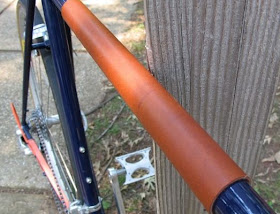First get some VO cork grips. You'll also need a small can of amber shellac from the local paint store. While at the paint store, also pick up a disposable brush, but get the biodgradable wood type, not plastic.
Shellac is a resin secreted by the female lac bug, on trees in the forests of India and Thailand. It's made into flakes that are mixed with alcohol to make a varnish-like coating. You can buy flakes and mix them yourself, but for this little project I wouldn't bother.
Make a little stand for the grips by sticking a couple of pencils into a cardboard box. Slide the grips over the pencils and brush on a thin coat of shellac. Allow to dry for an hour or so, or until no longer tacky, then brush on a second coat. I like about 4 coats total; putting on more will add gloss, but it will also make the grips a little slippery. In between coats put the brush in an airtight ziplock bag to keep it from drying out.
When the last coat dries, slip the grips over your bars. Remember that cork grips fit 22.2mm bars, not 23.8mm. Usually cork grips fit too loosely for my taste, so I put a strip of tape over the bar first; it could be duct tape, handlebar tape - anything that takes up space. Push the grips on gently as it's easy to tear them. That's all there is to it--go for a ride.



















